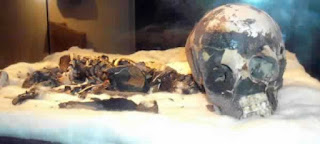The Mummy:
The cave showed signs of being occupied at different periods, and its walls were painted with images of people, animals, cattle, and scratched with graffiti. This was an opportunity probably the kind professor Mori was searching for. As the cave's floor was sandy and soft to dig, the professor could not resist the rare opportunity to be the first to excavate the cave. Not long and not far from the surface he found what appeared to be a strange bundle of some sort. Upon careful investigation it turned out to be of a mummy of a child carefully wrapped in a goatskin, with its entrails replaced by wild herbs, probably to aid preservation.The child is thought to have been 3 years old at the time of death. Using radiocarbon 14 method, the mummy was thought to be between 5,400 and 5,600 years old, which makes it much older than any of the mummies found in (neighbouring) ancient Egypt. It was believed that the makers of the mummy were cattle herders, and occupied much of North Africa, at a time when the Sahara was a savannah.
This is the info displayed beneath the mummy in the museum (see the above photo), stating the age of the child, the location of the discovery (Wadi Tashwinat), the age of the mummy, and that it was wrapped in plants. Later research showed that the mummy was placed in a foetal position, embalmed, covered with antelope skin, and wrapped with leaves. This prehistoric Libyan technique did indeed protect the body for 5,600 years.
Wan Muhuggiag Periods:
The archaeological finds at the site indicate that it was occupied by humans at different times. The most recent layer contained stone tools, such as querns, and a horned cattle skull, probably as an emblem of the sun; while the oldest layer contained stone slabs, typically used during that period for proper burial (see Germa Museum for details on this).- 5400 years ago
- 7850 years ago
- 7600 years ago
https://www.temehu.com/wan-muhuggiag.htm



No hay comentarios:
Publicar un comentario